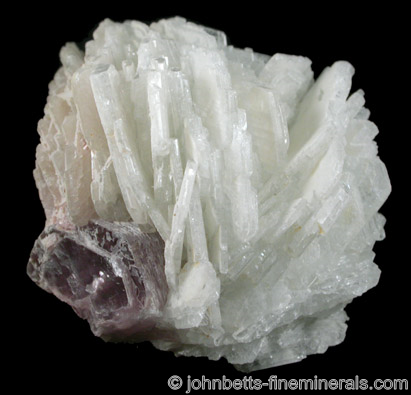The plagioclase Mineral Series

The Plagioclase series is a group of related feldspar minerals that essentially have the same formula but vary in their percentage of sodium and calcium. Albite and Anorthite are the end members of the series, with the intermediary minerals Oligoclase, Andesine, Labradorite, and Bytownite.
The acclaimed Dana's System of
Mineralogy lists the intermediary members as individual minerals,
whereas the IMA does not recognize them as individual mineral
species. Thus, some consider Oligoclase and Andesine to be a variety of
Albite, and Labradorite and Bytownite to be a variety of Anorthite. For convenience to the reader, this guide will dedicate a page for each intermediary member.
The Plagioclase Feldspars are important rock-forming minerals and occur in numerous mineral environments. In many instances, it is very hard to tell apart one from another. When a particular Plagioclase Feldspar cannot be identified, it is simply called "Plagioclase" or "Plagioclase Feldspar". The percentages of sodium and calcium for each member listed above are an approximate value; the actual percentage can vary as much as 20 percent.
Chemical Formula
(Na,Ca)Al1-2Si3-2O8
Variations in the amount of sodium and calcium; and aluminum and silicon, form different minerals in this series:
| |
Amount of sodium and calcium
|
Percentage of Albite (Ab)and Anorthite (An)
|
|
Albite
|
(Na100% , Ca 0%
) Al Si3O8
|
90-100% Ab
; 0-10% An
|
|
Oligoclase
|
(Na90% , Ca10%
) Al1-2Si3-2O8
|
70-90% Ab
; 10-30% An
|
|
Andesine
|
(Na70% , Ca30%
) Al1-2Si3-2O8
|
50-70% Ab
; 30-50% An
|
|
Labradorite
|
(Ca70% , Na30%
) Al1-2Si3-2O8
|
30-50% Ab
; 70-50% An
|
|
Bytownite
|
(Ca90% , Na10%
) Al1-2Si3-2O8
|
10-30% Ab
; 70-90% An
|
|
Anorthite
|
(Ca100% , Na0%
) Al2Si2O8
|
0-10% Ab
; 90-100% An
|
Actual formula of end
members are:
In Anorthite, an aluminum molecule takes the place of a silicon molecule. The intermediary members of this series contain an intermediary amount of sodium and calcium, as well as aluminum and silicon.
Color
White, colorless, cream, gray, yellow, orange, pink, green, blue, red, brown, black
Properties
Streak
White |
Hardness
6 - 6.5 |
Transparency
Transparent to translucent |
Specific Gravity
2.6 - 2.8 |
Luster
Vitreous. Pearly on cleavage surfaces. |
Cleavage
2,1 - basal ; 2,1 - prismatic ; 3,1 - pinacoidal. The cleavage angle is about 90º. |
Fracture
Conchoidal to uneven |
Tenacity
Brittle |
Uses
The Plagioclase Feldspars are used in ceramics. Three varieties have gemstone uses: Labradorite, Moonstone, and Sunstone.
Noteworthy Localities
See the individual group members for localities.
Distingushing Similar Minerals
Potassium Feldspar Group - Don't exhibit striations on twinned crystal surfaces, whereas the Plagioclase Feldspars may. Otherwise difficult to distinguish.
Spodumene - Has a splintery fracture.
Calcite - Much lower hardness.
plagioclase
Photos
Below is an image for each one of the members of the Plagioclase group. Additional images of each member mineral is indexed on the individual member pages.